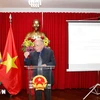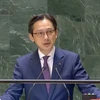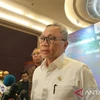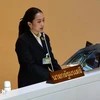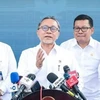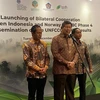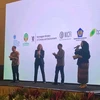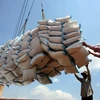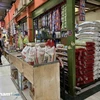The Philippine trade, which for the past 20 years focused on its traditional markets – US, Europe, Japan and China – has now shifted to ASEAN, making it a must for Filipino enterprises to take advantage of the ASEAN trading regime by 2015.
According to the Manila Bulletin, Philippine Trade and Industry Undersecretary Ponciano C. Manalo pointed this out at the recent National Exporters’ Congress Week, which gathered the country’s largest exporters and small and medium enterprises.
“With the recent developments, we have seen a significant shift from the traditional markets to our neighboring countries in ASEAN,” Manalo said.
For the last 20 years, the Philippine export market focused on United States , Europe, Japan and China , but ASEAN is fast catching up.
In 2012, Manalo said, total trade between the Philippines and ASEAN amounted to 24 billion USD or 21 percent of the country’s total trade. In the same year, the ASEAN bloc accounts for 7.3 percent of total approved investments in the Philippines amounting to P21 billion, a significant seven-fold increase from P3 billion in 2011.
In contrast, Japan ’s share of the country’s total trade accounted for 19 percent, the US with 14.2 percent, China with 11.8 percent and EU with 11.4 percent.
“ASEAN is an important economic partner of the Philippines , both on the trade and investment fronts,” Manalo said.
Despite the growth in share of Philippine trade with ASEAN, the country, however, Philippines has been incurring huge trade deficits with ASEAN for the past five years.
Data showed that the original ASEAN member incurred its highest trade deficit in 2008 with 7.543 billion USD, followed by 5.601 billion USD in 2011 and 5,124 billion USD in 2009. Lower trade deficits were incurred in 2012 with 4.307 billion USD and in 2010 with 3.947 billion USD.
It can be gleaned from the DTI data that the oil imports account for the bulk of the Philippines imports from her fellow ASEAN countries. Other huge imports from ASEAN include rice, petrochemicals, and automotives.
With the Philippines nearly becoming self-sufficient in rice production, the country is expected to incur lower volume of rice imports from Thailand and Vietnam .
The country’s top ten imports from ASEAN include electrical, electronic equipment with 20 percent share of total followed by mineral fuels, oils and distillation product group to account for 14.8 percent.
Importation of machinery, nuclear reactors, boilers account for 11.4 percent while motor vehicles account for 8.9 percent of total imports from ASEAN. Other imports include plastics and articles thereof; miscellaneous edible preparations; animal, vegetable fasts and oils, cleavage products; cereals; essential oils, perfumes, cosmetics, toiletries; and optical, photo, technical, medical.
Electrical and electronic equipment is the single largest export product of the Philippines to ASEAN with a whopping 59.5 percent of its total exports to the region.
Other exports are machinery, nuclear reactors, boilers account for 8.4 percent while motor vehicles contributed 5.1 percent.
Other exports include mineral fuels, oils and distillation products; optical, photo, technical, medical apparatus; copper and articles thereof; tobacco and manufactured tobacco cereal, flour, starch, milk preparations and products and fertilizers.
But such huge trade deficit presents opportunities for Filipino exporters. As Manalo said, ASEAN represents one of the biggest markets in the world with its more than 600 million young and dynamic population. It has a total aggregate gross domestic product (GDP) of 2.3 billion USD and an average per capita of 3,751 USD.
Manalo further reminded the private sector that business, more than government, will drive regional integration.
He noted that it is business that will take advantage of the opportunities offered by a single market as well as the wide and varied complementation networks of a regional supply chain within ASEAN and its six free trade agreement (FTA) partners, namely, China , Japan , the Republic of Korea , Australia , New Zealand , and India .
By 2015, the ASEAN Economic Community (AEC) will transform the 10 member-states of ASEAN into a single market and production base. The AEC integration aims to achieve five main pillars – free trade in goods, free trade in services, free flow of skilled labor, free flow of investments and free flow of capital enabling the region to minimise transaction costs and maximise trade gains.-VNA
According to the Manila Bulletin, Philippine Trade and Industry Undersecretary Ponciano C. Manalo pointed this out at the recent National Exporters’ Congress Week, which gathered the country’s largest exporters and small and medium enterprises.
“With the recent developments, we have seen a significant shift from the traditional markets to our neighboring countries in ASEAN,” Manalo said.
For the last 20 years, the Philippine export market focused on United States , Europe, Japan and China , but ASEAN is fast catching up.
In 2012, Manalo said, total trade between the Philippines and ASEAN amounted to 24 billion USD or 21 percent of the country’s total trade. In the same year, the ASEAN bloc accounts for 7.3 percent of total approved investments in the Philippines amounting to P21 billion, a significant seven-fold increase from P3 billion in 2011.
In contrast, Japan ’s share of the country’s total trade accounted for 19 percent, the US with 14.2 percent, China with 11.8 percent and EU with 11.4 percent.
“ASEAN is an important economic partner of the Philippines , both on the trade and investment fronts,” Manalo said.
Despite the growth in share of Philippine trade with ASEAN, the country, however, Philippines has been incurring huge trade deficits with ASEAN for the past five years.
Data showed that the original ASEAN member incurred its highest trade deficit in 2008 with 7.543 billion USD, followed by 5.601 billion USD in 2011 and 5,124 billion USD in 2009. Lower trade deficits were incurred in 2012 with 4.307 billion USD and in 2010 with 3.947 billion USD.
It can be gleaned from the DTI data that the oil imports account for the bulk of the Philippines imports from her fellow ASEAN countries. Other huge imports from ASEAN include rice, petrochemicals, and automotives.
With the Philippines nearly becoming self-sufficient in rice production, the country is expected to incur lower volume of rice imports from Thailand and Vietnam .
The country’s top ten imports from ASEAN include electrical, electronic equipment with 20 percent share of total followed by mineral fuels, oils and distillation product group to account for 14.8 percent.
Importation of machinery, nuclear reactors, boilers account for 11.4 percent while motor vehicles account for 8.9 percent of total imports from ASEAN. Other imports include plastics and articles thereof; miscellaneous edible preparations; animal, vegetable fasts and oils, cleavage products; cereals; essential oils, perfumes, cosmetics, toiletries; and optical, photo, technical, medical.
Electrical and electronic equipment is the single largest export product of the Philippines to ASEAN with a whopping 59.5 percent of its total exports to the region.
Other exports are machinery, nuclear reactors, boilers account for 8.4 percent while motor vehicles contributed 5.1 percent.
Other exports include mineral fuels, oils and distillation products; optical, photo, technical, medical apparatus; copper and articles thereof; tobacco and manufactured tobacco cereal, flour, starch, milk preparations and products and fertilizers.
But such huge trade deficit presents opportunities for Filipino exporters. As Manalo said, ASEAN represents one of the biggest markets in the world with its more than 600 million young and dynamic population. It has a total aggregate gross domestic product (GDP) of 2.3 billion USD and an average per capita of 3,751 USD.
Manalo further reminded the private sector that business, more than government, will drive regional integration.
He noted that it is business that will take advantage of the opportunities offered by a single market as well as the wide and varied complementation networks of a regional supply chain within ASEAN and its six free trade agreement (FTA) partners, namely, China , Japan , the Republic of Korea , Australia , New Zealand , and India .
By 2015, the ASEAN Economic Community (AEC) will transform the 10 member-states of ASEAN into a single market and production base. The AEC integration aims to achieve five main pillars – free trade in goods, free trade in services, free flow of skilled labor, free flow of investments and free flow of capital enabling the region to minimise transaction costs and maximise trade gains.-VNA
